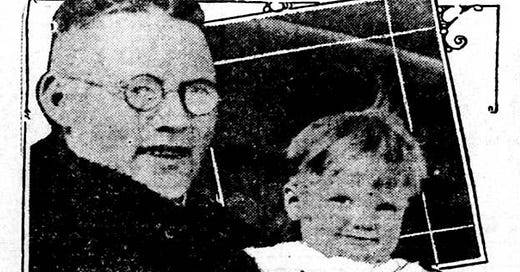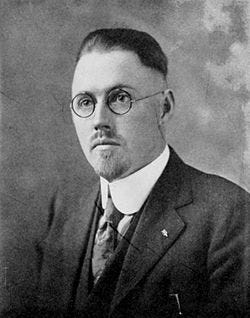(25)
John Romulus Brinkley has so many weird things associated with his history, it’s hard to know where to begin.
Perhaps with the weirdest:
He gained international fame, and infamy, through his practice of xenotransplantation of goat testicles into humans. I am not making this up; as I’ve said before, I don’t have that much imagination.
It’s true, Wikipedia says he gained reputation early on with claims the operation would improve sexual prowess. Later in his career he expanded that to include curative powers for 27 ailments, ranging from dementia to emphysema to flatulence (no comment).
Oh, by the way, he had no legitimate medical degree, only three-fourths completion of the program at a medical school of questionable reputation and a certificate from a diploma mill. But by all accounts, he was a talented surgeon.
(John R. Brinkley, 1885-1942. He actually looks somewhat reasonable. Wikipedia)
Wikipedia hastens to note that the “transplantation” had no medical benefit; the implanted material was simply absorbed into the recipient’s body. But the procedure often was conducted in unsanitary conditions, Brinkley was sometimes drunk, and his patients were sometimes left with infections and death.
However, an article available through PubMed Central said, perhaps with tongue in cheek, that "although any benefits were unlikely, the ... possibilities have never been explored scientifically." Repeat after me: You Can't Prove a Negative. Who knows? (But don't try getting your neighborhood primary care doctor to eviscerate the family pet goat).
Benefits or no, Brinkley was much in demand, and the procedure was priced at a princely $750 (almost $16,000 today).
(1920 newspaper ad. The old Arizona Republican)
At the height of his career, he had amassed millions of dollars, but he died nearly penniless as a result of the large number of malpractice, wrongful death, and fraud suits brought against him. (Wikipedia)
Early on, Brinkley married, had a child, divorced, kidnapped his child, fled to Canada, returned to the U.S. and remarried his ex-wife, and married a second woman while still married to No. 1, eventually divorcing No. 1, according to the Texas Farm Bureau’s Texas Heritage and Wikipedia. He ran for governor of Kansas twice, almost winning once, and opened a hospital and a radio station there.
And then he came to Texas.
He eventually lived in what is now a fairly famous mansion in Del Rio along the Rio Grande that featured dancing fountains illuminated at night and pulsing in rhythm with broadcast music. (Texas Heritage article by Peter Simek).
From there, he contracted with the Mexican government to set up what came to be called a Border Blaster radio station across the river in Villa (now Ciudad) Acuña, Mexico, but his studio was in his home, connected by telephone lines. The station, XEG (AM), was originally operated at 50,000 watts, giving it a nighttime range over half the country. It was eventually increased to a million watts(!), giving it range over half the world. US broadcasters were limited to 50,000, and then only at night for clear-channel stations.
Del Rio residents said they didn’t need radios to hear the broadcasts, which featured popular music by such up and coming artists as Gene Autry, Jimmie Rogers, (Oxford comma!) and the Carter Family, giving Del Rio the title of Hillbilly Hollywood. Some reports even said the broadcast waves were so strong they turned on car headlights.
And the commercials! Questionable advertisers, banned in the US, flocked to the blasters. Included were spots for Brinkley’s various offerings and hucksters offering such things as autographed portraits of Jesus Christ, where “his eyes open and close” (I personally heard one of those as a kid in the '50s).
At first, Brinkley and his second (third?) wife lived in the Roswell Hotel in Del Rio and opened a hospital on three floors, where he performed various, and expensive, medical procedures, which made him rich enough to build the mansion with the dancing waters on the river. It sat on 16 acres, featured a menagerie of exotic animals imported from the Galapagos Islands, a swimming pool with a 10-foot-tall diving platform, and a collection of a dozen Cadillacs. (Wikipedia)
(The Brinkley Mansion. Val Verde County Historical Commission)
All went fairly well for him until an old nemesis, Morris Fishbein, then editor of the Journal of the American Medical Association, published a two-part expose called Modern Medical Charlatans that pretty well exposed all of Brinkley’s misdeeds. In what turned out to be a very large mistake, Brinkley sued for libel and $250,000 in damages (more than $5 million today). The jury in Texas judge R.J. McMillan’s court found for Fishbein, pretty well ending Brinkley’s career and income. The jury said Brinkley "should be considered a charlatan and a quack in the ordinary, well-understood meaning of those words." (Wikipedia)
That verdict opened the door for a score of lawsuits against him; the Internal Revenue Service investigated him for tax fraud, and the U.S. Postal Service began an investigation into possible mail fraud.
Brinkley declared bankruptcy, fell into ill health and died in 1942 of heart failure.
A paper in the Journal of Community Hospital Internal Medicine Perspectives labeled Brinkley a "quintessential American quack." The paper, by Philip C. Smith and archived by PubMed Central, said "Brinkley's success illustrates how eager the public can be for panaceas, regardless of their actual merit, and the difficulty of interdicting the activities of quacks who have captured the public’s imagination.
"His medical training was limited, his treatments implausible, and yet, during a career that spanned over a quarter century, he became one of the best-known doctors of his era, through his use of technology, salesmanship, and politicking."
Despite all that he did and shouldn't have, the paper said, "in a certain perverted sense, he was one of the great medical minds of his era. He drew attention to two subjects largely ignored by medicine during that time _ aging and failing sexuality in older men. And though he knew his methods were worthless, he performed them with a technical competency and focus on the patient that was equal to or better than reputable doctors of his era. Moreover, he demonstrated the power of mass communication in the practice of medicine, as perhaps the first doctor to use broadcasting to provide medical advice to the public at large. Even Brinkley’s critics admitted that he was a talented surgeon, communicator, and businessman."
All this is but a fraction of everything Brinkley did in his checkered career. For a really detailed rundown, if you’re interested, see this Wikipedia page:
https://en.wikipedia.org/wiki/John_R._Brinkley
And this PubMed Central paper:
https://pmc.ncbi.nlm.nih.gov/articles/PMC9529641/
Obscure Facts Dept:
Another of the Border Blasters across from Del Rio was XERF (previously XERA), which later famously featured a DJ named _ wait for it _ Wolfman Jack. At XERF, the Wolfman (real name Robert Weston Smith) developed his signature style (with phrases such as, "Who's this on the Wolfman telephone?") and widespread fame. The border stations made money by renting time to Pentecostal preachers and psychics, and by taking 50% of the profit from anything sold by mail order.
There are numerous 50,000-watt AM stations in Texas, but only a few are clear-channel, allowing them to broadcast at full power at night (when broadcasts travel much further). The first, D/FW radio station WBAP-AM (820 kHz), went on the air May 2, 1922. KRLD (1080) is another D/FW clear-channel station. Others are KTRH (740) in Houston and WOAI (1200) in San Antonio.
Smart Alec Question of the Day:
What movie helped boost Wolfman Jack’s career? (Answer below, but you should know this one).
Notes:
https://blog.txfb-ins.com/texas-living/weird-history-dawn-of-radio/
https://en.wikipedia.org/wiki/John_R._Brinkley
https://en.wikipedia.org/wiki/Wolfman_Jack
PubMed Central is a part of the National Institutes of Health/National Library of Medicine:
https://pmc.ncbi.nlm.nih.gov/articles/PMC9529641/
And the Answer:
American Graffiti. (The Wolfman also was briefly on D/FW rock music station Y95, which later became Contemporary Christian music station KLTY and now is part of the K-LOVE network, also Contemporary Christian music.)
Next: A Head of the Class
Thanks for reading! Consider subscribing. Free option!






